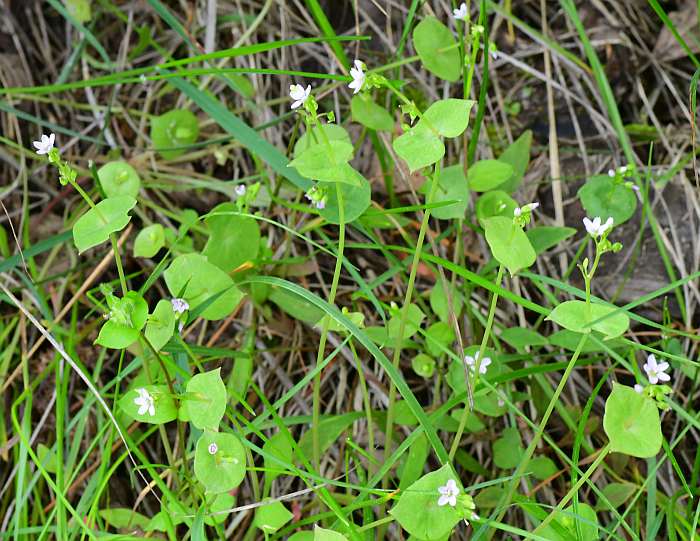Claytonia perfoliata Donn ex Willd.
Miner's Lettuce

Introduced
CC = *
CW = 3
MOC = 1
© SRTurner
Claytonia perfoliata Donn ex Willd.Miner's Lettuce | |
 |
Introduced CC = * CW = 3 MOC = 1 |
© SRTurner |
|
Family - Portulacaceae Habit - Annual forb.
Stems - Spreading to erect, to 40 cm, glabrous. Leaves - Basal and cauline, simple. Basal leaves petiolate, to 4 cm, rounded and less than 3 times longer than wide, elliptic to reniform, the tips rounded to acute. Stem leaves 2, fused around stem, rounded or obtuse-angled.
Inflorescences - Terminal stalked racemes of 5-40 flowers, these tending to all point in the same direction, subtended by an inconspicous bract.
Flowers - Sepals 1.5-5 mm, herbaceous. Petals 5, 2-6 mm long, white to pink. Stamens 5, ovary with one locule, style 1, stigmas 3.
Fruits - Capsules with 3 valves, 1.5-4.0 mm, forcibly ejecting seeds at dehiscence. Seeds 1.2-2.7 mm, ovate to round, shiny, smooth. Flowering - May. Habitat Origin - Native to the U.S. Lookalikes - None. Other info. - This small but distinctive plant has only been found in Missouri near the greenhouses of Missouri Botanical Garden. Its occurrence there is probably the result of seeds imported unintentionally as a contaminant of bedding mix. It is listed here because there is the potential for the plants to have escaped from there into the wild, though no escapes have been found thus far and the likelihood of such an event is considered remote. The population is far disjunct from the plant's normal range, which is the western third of the continental U.S. There, it is common. The plant is recognized by its single pair of fused leaves directly beneath the inflorescence, and by the flowers, which are very similar to, though smaller than, those of C. virginica (spring beauty), a very common species in Missouri. Photographs taken at Couer d'Alene, Kootenai County, ID, 5-15-2025 (SRTurner). |